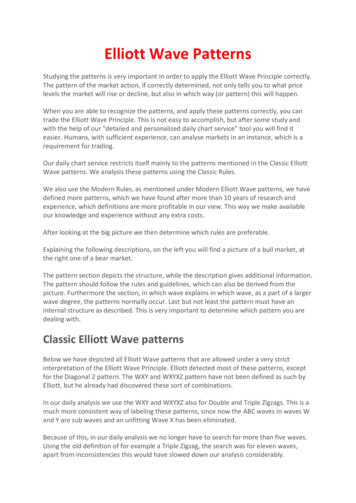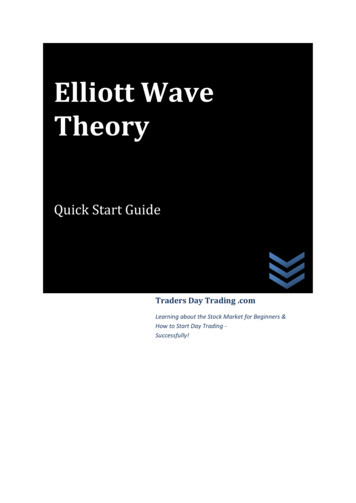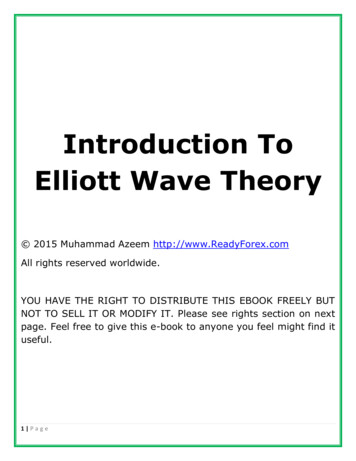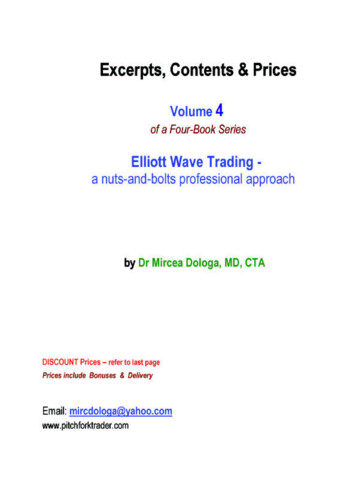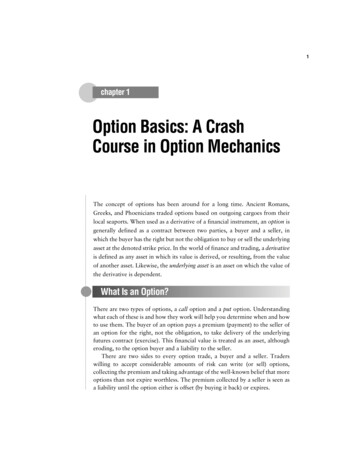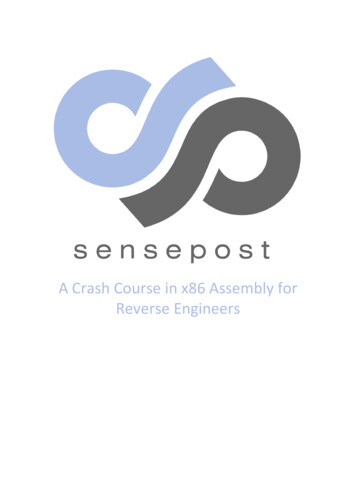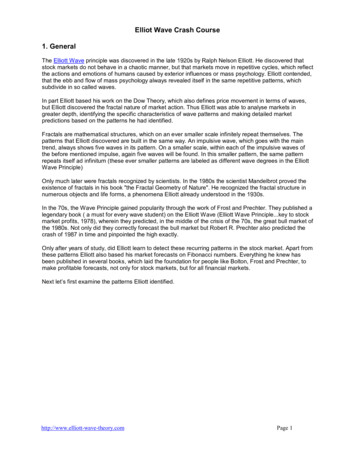
Transcription
Elliot Wave Crash Course1. GeneralThe Elliott Wave principle was discovered in the late 1920s by Ralph Nelson Elliott. He discovered thatstock markets do not behave in a chaotic manner, but that markets move in repetitive cycles, which reflectthe actions and emotions of humans caused by exterior influences or mass psychology. Elliott contended,that the ebb and flow of mass psychology always revealed itself in the same repetitive patterns, whichsubdivide in so called waves.In part Elliott based his work on the Dow Theory, which also defines price movement in terms of waves,but Elliott discovered the fractal nature of market action. Thus Elliott was able to analyse markets ingreater depth, identifying the specific characteristics of wave patterns and making detailed marketpredictions based on the patterns he had identified.Fractals are mathematical structures, which on an ever smaller scale infinitely repeat themselves. Thepatterns that Elliott discovered are built in the same way. An impulsive wave, which goes with the maintrend, always shows five waves in its pattern. On a smaller scale, within each of the impulsive waves ofthe before mentioned impulse, again five waves will be found. In this smaller pattern, the same patternrepeats itself ad infinitum (these ever smaller patterns are labeled as different wave degrees in the ElliottWave Principle)Only much later were fractals recognized by scientists. In the 1980s the scientist Mandelbrot proved theexistence of fractals in his book "the Fractal Geometry of Nature". He recognized the fractal structure innumerous objects and life forms, a phenomena Elliott already understood in the 1930s.In the 70s, the Wave Principle gained popularity through the work of Frost and Prechter. They published alegendary book ( a must for every wave student) on the Elliott Wave (Elliott Wave Principle.key to stockmarket profits, 1978), wherein they predicted, in the middle of the crisis of the 70s, the great bull market ofthe 1980s. Not only did they correctly forecast the bull market but Robert R. Prechter also predicted thecrash of 1987 in time and pinpointed the high exactly.Only after years of study, did Elliott learn to detect these recurring patterns in the stock market. Apart fromthese patterns Elliott also based his market forecasts on Fibonacci numbers. Everything he knew hasbeen published in several books, which laid the foundation for people like Bolton, Frost and Prechter, tomake profitable forecasts, not only for stock markets, but for all financial markets.Next let’s first examine the patterns Elliott identified.http://www.elliott-wave-theory.comPage 1
Elliot Wave Crash Course2. Basic TheoryAccording to physical law: "Every action creates an equal and opposite reaction". The same goes for thefinancial markets. A price movement up or down must be followed by a contrary movement, as the sayinggoes: "What goes up must come down"( and vice versa).Price movements can be divided into trends on the one hand and corrections or sideways movements onthe other hand. Trends show the main direction of prices, while corrections move against the trend. InElliott terminology these are called Impulsive waves and Corrective waves.The Impulse wave formation has five distinct price movements, three in the direction of the trend (I, III,and V) and two against the trend ( II and IV).Obviously the three waves in the direction of the trend are impulses and therefore these waves also havefive waves. The waves against the trend are corrections and are composed of three waves.The corrective wave formation normally has three, in some cases five or more distinct price movements,two in the direction of the main correction ( A and C) and one against it (B). Wave 2 and 4 in the abovepicture are corrections. These waves have the following structure:Note that these waves A and C go in the direction of the shorter term trend, and therefore are impulsiveand composed of five waves, which is shown in the picture above.An impulse wave formation followed by a corrective wave, form an Elliott wave degree, consisting of trendand counter trend. Although the patterns pictured above are bullish, the same applies for bear markets,where the main trend is down.http://www.elliott-wave-theory.comPage 2
Elliot Wave Crash CourseThe following example shows the difference between a trend (impulse wave) and a correction (sidewaysprice movement with overlapping waves). It also shows that larger trends consists of (a lot of ) smallertrends and corrections, but the result is always the same.Very important in understanding the Elliott Wave Principle is the basic concept that wave structures of thelargest degree are composed of smaller sub waves, which are in turn composed of even smaller subwaves, and so on, which all have more or less the same structure ( impulsive or corrective) like the largerwave they belong to.http://www.elliott-wave-theory.comPage 3
Elliot Wave Crash CourseElliott distinguished nine wave degrees ranging from two centuries to hourly. Below, these wave degreesare listed together with the style we use to distinguish them:Wave degreeTrendCorrectionGrand inuteMinuetteSub minuetteIn theory the number of wave degrees are infinite, in practice you can spot about four more wave degreesif you examine at tick charts.This indicates that you can trade the investment horizon, which is most suited for you, from veryaggressive intra day trading to longer term investing. The same rules and patterns apply over and overagain. Now we will take a look at the patterns.3. PatternsStudying the patterns is very important in order to apply the Elliott Wave Principle correctly. The pattern ofthe market action, if correctly determined, not only tells you to what price levels the market will rise ordecline, but also in which way (or pattern) this will happen.When you are able to recognize the patterns, and apply these patterns correctly, you can trade the ElliottWave Principle. This is not easy to accomplish, but after some study and with the help of our "detailed andpersonalized daily chart service" tool you will find it easier. Humans, with sufficient experience, cananalyse markets in an instance, which is a requirement for trading.Our daily chart service restricts itself mainly to the patterns mentioned in the Classic Elliott Wavepatterns. We analysis these patterns using the Classic Rules.We also use the Modern Rules, as mentioned under Modern Elliott Wave patterns, we have definedmore patterns, which we have found after more than 10 years of research and experience, whichdefinitions are more profitable in our view. This way we make available our knowledge and experiencewithout any extra costs.After looking at the big picture we then determine which rules are preferable.Explaining the following descriptions, on the left you will find a picture of a bull market, at the right one of ahttp://www.elliott-wave-theory.comPage 4
Elliot Wave Crash Coursebear market.The pattern section depicts the structure, while the description gives additional information. The patternshould follow the rules and guidelines, which can also be derived from the picture. Furthermore thesection, in which wave explains in which wave, as a part of a larger wave degree, the patterns normallyoccur. Last but not least the pattern must have an internal structure as described. This is very importantto determine which pattern you are dealing with.Classic Elliott Wave patternsBelow we have depicted all Elliott Wave patterns that are allowed under a very strict interpretation of theElliott Wave Principle. Elliott detected most of these patterns, except for the Diagonal 2 pattern. The WXYand WXYXZ pattern have not been defined as such by Elliott, but he already had discovered these sort ofcombinations.In our daily analysis we use the WXY and WXYXZ also for Double and Triple Zigzags. This is a muchmore consistent way of labeling these patterns, since now the ABC waves in waves W and Y are subwaves and an unfitting Wave X has been eliminated.Because of this, in our daily analysis we no longer have to search for more than five waves. Using the olddefinition of for example a Triple Zigzag, the search was for eleven waves, apart from inconsistencies thiswould have slowed down our analysis considerably.I. Trendsa. Impulse PatternDescriptionImpulses are always composed of five waves, labeled 1,2,3,4,5. Waves 1, 3 and 5 are themselves eachimpulsive patterns and are approximately equal in length. Waves 2 and 4 on the contrary are alwayscorrective patterns.Rules and guidelinesThe most important rules and guidelines are: Wave 2 cannot be longer in price than wave 1, and it must not go beyond the origin ofwave 1.Wave 3 is never the shortest when compared to waves 1 and 5.Wave 4 cannot overlap wave 1, except in diagonal triangles and sometimes in wave 1 orA waves, but never in a third wave. In most cases there should not be an overlap betweenwave 1 and A.http://www.elliott-wave-theory.comPage 5
Elliot Wave Crash Course As a guideline the third wave shows the greatest momentum, except when the fifth is theextended wave.Wave 5 must exceed the end of wave 3.As a guideline the internal wave structure should show alternation, which means differentkind of corrective structures in wave 2 and 4.In which waveImpulse patterns occur in waves 1, 3, 5 and in waves A and C of a correction( this correction could be awave 2, 4 or a wave B, D, E or wave X).Internal structureIt is composed of five waves. The internal structure of these waves is 5-3-5-3-5. Note that the mentioned3s are corrective waves, which should be composed of 5 waves in a corrective triangle.b. Extension PatternDescriptionBy definition an extension occurs in an impulsive wave, where waves 1, 3 or 5 can be extended, beingmuch longer than the other waves. It is quite common that one of these waves will extend, which isnormally the third wave. The two other waves then tend to equal each other.In our pattern definitions we call it an Extension1 if the first wave extends, an Extension3 if the 3rd waveextends and an Extension5 if the 5th wave extends.Rules and guidelinesThe most important rules and guidelines concerning an extended wave are: It is composed of 5, 9, 13 or 17 waves.Wave 2 cannot be longer in price length than wave 1, so it should not go beyond theorigin of wave 1.Wave 3 is never the shortest when compared to waves 1 and 5.Wave 4 cannot overlap wave 1.Wave 5 exceeds the end of wave 3.The extended wave normally shows the highest acceleration.In which wavehttp://www.elliott-wave-theory.comPage 6
Elliot Wave Crash CourseExtensions occur in waves 1, 3, 5, and in A and C waves, when compared to each other.Internal structureAs a minimum it is composed of 9 waves, though 13 or 17 waves could occur. So the minimal internalstructure of the 9 waves is 5-3-5-3-5-3-5-3-5. Note that the 3s mentioned are corrective waves, whichcould be composed of 5 waves in the case of a corrective triangle.c. Diagonal triangle type 1 PatternDescriptionDiagonals are sort of impulsive patterns, which normally occur in terminal waves like a fifth or a C wave.Don’t confuse them with corrective triangles.Diagonals are relatively rare phenomena for large wave degrees, but they do occur often in lower wavedegrees on intra-day charts. Usually Diagonal triangles are followed by a violent change in marketdirection.Rules and guidelinesThe most important rules and guidelines are: It is composed of 5 waves.Waves 4 and 1 do overlap.Wave 4 can’t go beyond the origin of wave 3.Wave 3) cannot be the shortest wave.Internally all waves of the diagonal have a corrective wave structure.Wave 1 is the longest wave and wave 5 the shortest.The channel lines of Diagonals must converge.As a guideline the internal wave structure should show alternation, which means differentkind of corrective structures.In which waveDiagonal triangles type 1 occur in waves 5, C and sometimes in wave 1.Internal structureThe internal structure of the five waves is 3-3-3-3-3.http://www.elliott-wave-theory.comPage 7
Elliot Wave Crash Coursec. Diagonal triangle type 2 PatternDescriptionDiagonal type 2 is a sort of impulsive pattern, which normally occurs in the first or A wave. The maindifference with the Diagonal Triangle type 1 is the fact that waves 1, 3 and 5 have an internal structure offive waves instead of three. Experience shows it can also occur in a wave 5 or C, though the Elliott WavePrinciple does not allow this. Don’t confuse this with corrective triangles.Diagonals are relatively rare phenomena for large wave degrees, but they do occur often in lower wavedegrees in intra day charts. These Diagonal triangles are not followed by a violent change in marketdirection, because it is not the end of a trend, except when it occurs in a fifth or a C wave.Rules and guidelinesThe most important rules and guidelines are: It is composed of 5 waves.Wave 4 and 1 do overlap.Wave 4 can’t go beyond the origin of wave 3.Wave 3) cannot be the shortest wave.Internally waves 1, 3 and 5 have an impulsive wave structure.Wave 1 is the longest wave and wave 5 the shortest.As a guideline the internal wave structure should show alternation, which means thatwave 2 and 4 show a different kind of corrective structure.In which waveDiagonal triangles type 2 occur in waves 1 and A.Internal structureThe five waves of the diagonal type 2 show an internal structure of 5-3-5-3-5.http://www.elliott-wave-theory.comPage 8
Elliot Wave Crash Coursed. Failure or Truncated 5th PatternDescriptionA failure is an impulsive pattern in which the fifth wave does not exceed the third wave. Fifth waves, whichtravel only slightly beyond the top of wave 3, can also be classified as a kind of failure. It indicates that thetrend is weak and that the market will show acceleration in the opposite direction.Rules and guidelinesThe most important rule
Classic Elliott Wave patterns Below we have depicted all Elliott Wave patterns that are allowed under a very strict interpretation of the Elliott Wave Principle. Elliott detected most of these patterns, except for the Diagonal 2 pattern. The WXY
